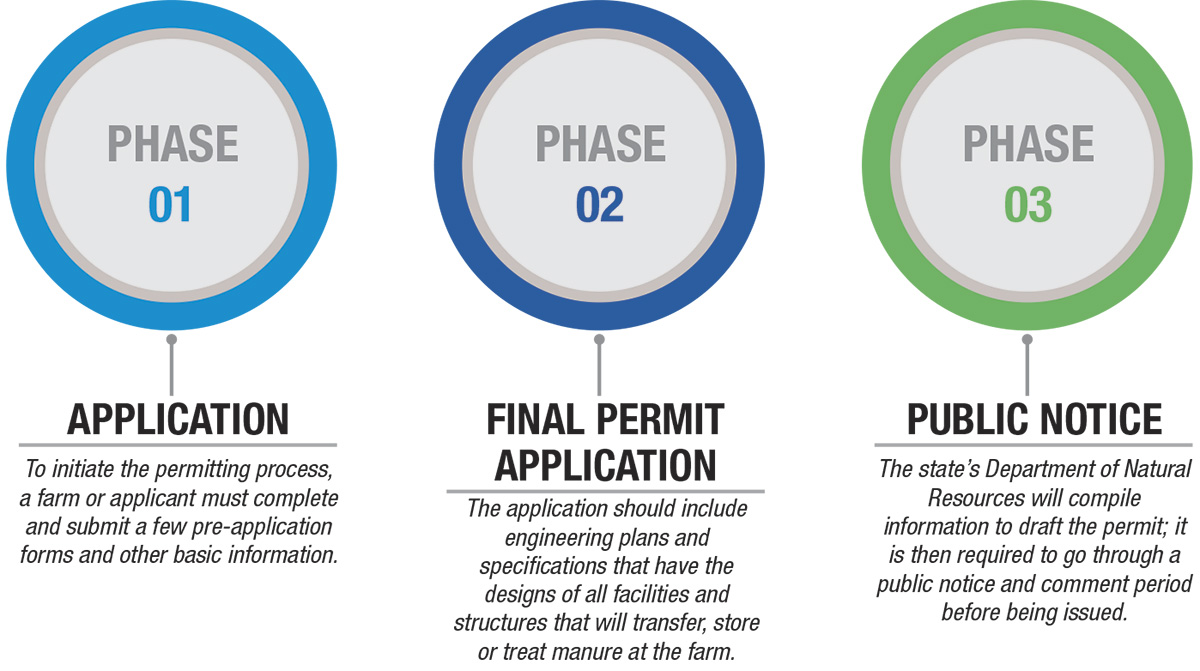Livestock farms of all sizes must properly manage all wastes produced by their operations. This includes the handling and storage of manure and all other wastewater produced by the farm, as well as land application or any other method of disposal. The most common practice for manure management is temporary storage at the farm’s production site and land spreading during specific periods throughout the year. There is a growing trend, mostly among larger dairy farms, to install on-farm treatment systems that process manure and other wastes to produce water that is safe to discharge directly to nearby surface water.
The technology for these treatment systems is not new and has been commonly used by other industries for decades. Using these systems for on-farm treatment and discharge has been explored and permitted for over a decade. With technological improvements, understanding of these systems, economics and many other factors, interest in the systems has grown significantly in the past two years.
There are currently a few of these on-farm treatment operations permitted and actively discharging in Wisconsin, and it is anticipated that many more systems will be functioning sometime in 2024-25.
Any farm operation interested in treating manure and discharging treated water to surface waters or groundwater must obtain a Wisconsin Pollutant Discharge Elimination System (WPDES) permit from the Wisconsin Department of Natural Resources (DNR). These permits contain effluent limits, monitoring and reporting requirements, compliance schedules unique to that permittee, and are typically issued for a five-year period. Most farms currently permitted or pursuing a permit to discharge have an existing WPDES permit with the department’s Concentrated Animal Feeding Operations program. The existing permit is modified for these farms to incorporate the requirements to discharge treated effluent water to surface waters. A second, but less common, permitting approach is to obtain a WPDES permit through the department’s Industrial Wastewater program. The application process is split into three primary phases: the initial application of intent and site assessment, the final permit application, and permit drafting and public notice.

1. Application of intent and site assessment
To initiate the permitting process, a farm or applicant must complete and submit a few pre-application forms and other basic information, like the proposed discharge location and anticipated effluent concentrations. The DNR uses this information to evaluate the discharge location by reviewing the stream classification and water quality data available for the receiving water body. The department will then determine effluent limitations that will be included in the WPDES permit. This document is known as the planning limits memo.
2. Final permit application
Once the farm receives the planning limits memo, the farm will prepare a final application. For farms with a WPDES permit, this may be provided during the re-issuance process or as a modification anytime during the five-year permit term.
The application should include engineering plans and specifications that have the designs of all facilities and structures that will transfer, store or treat manure or other wastes at the farm; an alternative discharge limits (ADL) analysis of the quantity of pollutants proposed to be discharged; and other standard documents common with permit applications. The department must approve plans and specifications.
In addition, if a farm is located in a watershed with an approved total maximum daily load (TMDL) and cannot meet the associated limits through treatment, it must acquire environmentally equivalent pollutant reduction credits to offset the discharge load. This can be done through water quality trading or utilizing TMDL reserve capacity, if available.
3. Permit drafting and public notice
For the final phase of the permitting process, the department will compile information from the planning limits memo and the application documents to draft the permit. The permit is required to go through a public notice and comment period for a minimum of 30 days prior to being issued.
While there are currently just a few of these systems operating, with a handful more working through the permitting process, there are notable changes these treatment systems may have to a farm’s operation. One such change is the need for less manure storage. The water portion of the treated and discharged manure does not need storage space and is also not considered in the days of storage calculations. A second example is the potential changes to the farm’s nutrient management plan. These systems produce manure that is nutrient-concentrated, and much of the nitrogen is converted into an inorganic form and readily available to crops. The treatment process also significantly reduces pathogen levels and, as a result, may assist farms in eastern Wisconsin in meeting the requirements of Silurian Bedrock Performance Standards that were adopted in July 2018.
This article discussed Wisconsin Department of Natural Resources (DNR) permitting requirements. However, it is important to note that local governments may require additional permitting requirements, and any farm pursuing a waste treatment system should also reach out to their local government representatives.





